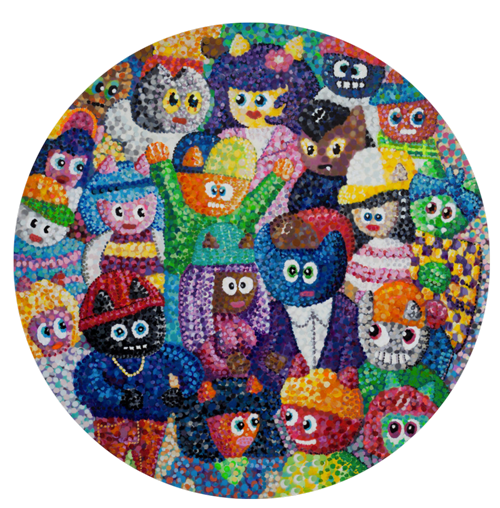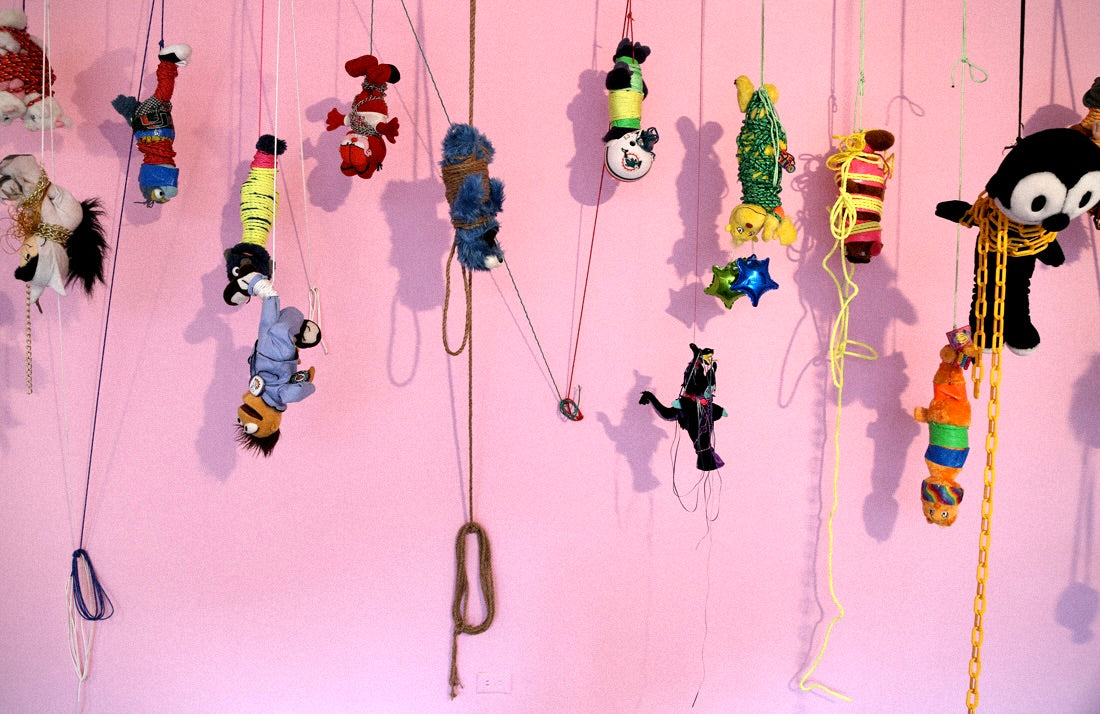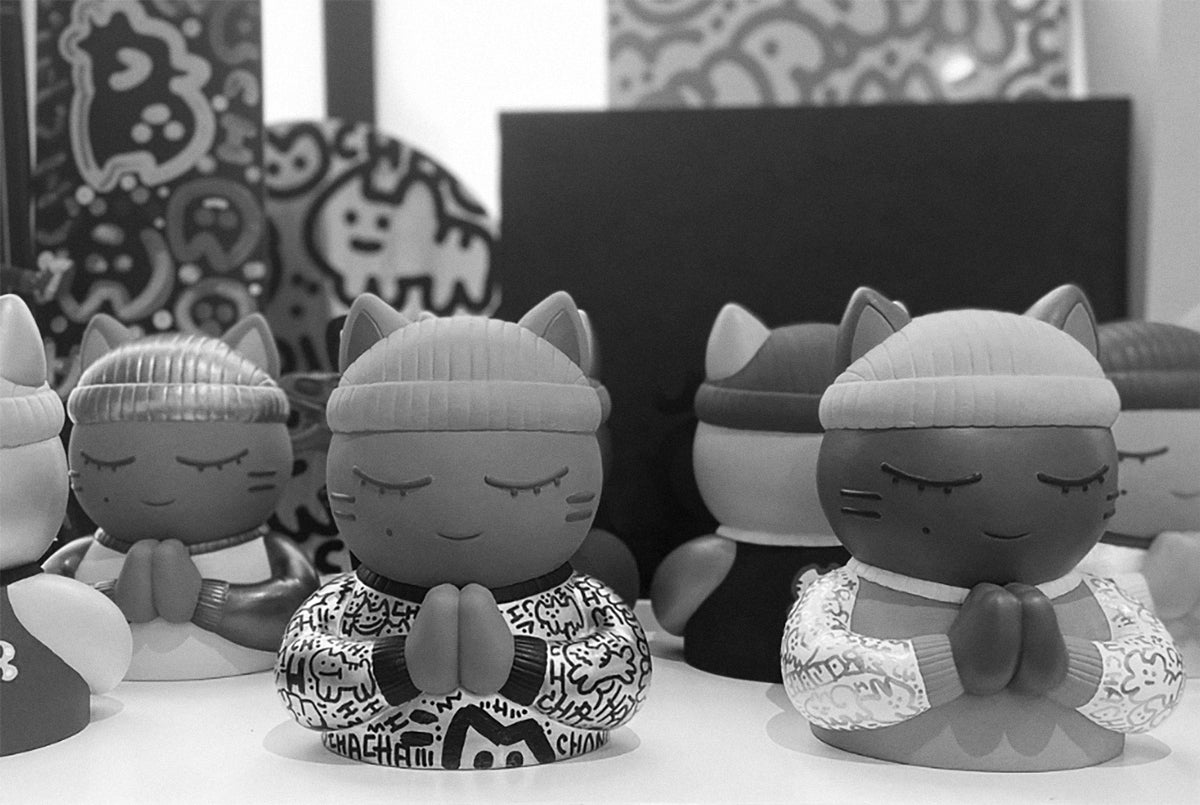Artist stories | CHANOIR


| INTERVIEW |
For nearly three decades, Chanoir's work has been seen in both urban spaces and institutional contemporary art circles. A Franco-Colombian artist trained at the Beaux-Arts in Paris, he has developed a unique pictorial language, at the crossroads of post-graffiti and free figuration, fueled by a joyful collective imagination and marked by a childlike spirit.
The feline figures he calls CHAS, true graphic totems, embody a quest for movement, universality, and connection. In this interview, CHANOIR reflects on his career, his influences, and the need to create an open, accessible body of work shaped by the visual languages of contemporary culture.
GALERIE VERMEULEN
You arrived in Paris from Bogota at the age of 6; how did you experience this uprooting?
CHANOIR
We followed my father, who was exhibiting at the Grand Palais, and he decided we would stay in France. I grew up surrounded by other artists who had made the same choice: my parents' friends were all painters, there were studios everywhere, and colorful characters. I don't know if it influenced me, but I quickly understood that there was a certain magic in that world.
Before we left, my parents had tried to prepare me for this country where people spoke a different language. So I had learned "yes," "no," and "hello," and I was super excited. But the day before we flew out, they handed me a down jacket. I said, "Why do I need something for the cold?" and I started to get scared [laughs]. After a sixteen-hour flight, I landed in a country that ultimately resembled mine... except that I didn't understand a word. For the first few months, I didn't even dare ask to go to the bathroom. I was shy, I even started to stutter a little. And since I couldn’t speak, I started hitting people—because I didn’t want them to think I was stupid. Which, in hindsight, was a pretty stupid idea… so maybe I was stupid after all! [laughs]


CHANOIR Installation - Museum of Contemporary Art of Bogota - 2015
GALERIE VERMEULEN
In what ways does your dual French-Colombian heritage find expression in your work?
CHANOIR
I feel above all of French culture, I grew up here, I did a science baccalaureate before the Beaux-Arts, I was nourished by television and public school. But at the same time, Colombia is always there, in the background. I speak Spanish every day, I regularly return to Bogotá, Cartagena and Las Islas. It's an unstable balance: as a child, I felt Colombian in France, then French in Colombia. It took me time to accept this double anchoring, this cultural schizophrenia which, ultimately, is a richness.
In my work, it's more unconscious. I have Latin American, Native American, and even pre-Columbian influences. There's something about these minimalist forms, these animal figures, that resonates with what I do. My cat, my CHA, is a totem. But my influences are multiple: manga, Japanese cartoons, global pop culture.
GALERIE VERMEULEN
You grew up alongside your father, himself an artist [ Gustavo Vejarano, editor's note]. How did this transmission influence your relationship with art?
CHANOIR
It's always a story of a son who has to dethrone his father, right? [laughs] Being a painter like my father was a challenge. There's a competitive dimension to art, like in graffiti. Over time, I understood that it wasn't a question of doing better, but of different trajectories, of paths that we actually trace for ourselves. What I inherited wasn't just the desire to paint, but the idea that painting is talking. A silent but continuous dialogue, the smell of turpentine, the vision of canvases drying, the cycle of creation that lasts a lifetime. My father passed on to me this idea that painting is an infinite conversation. If I can have a dialogue with painting as long as he did, then I will have had a good life.


"In painting, you sometimes have to unlearn in order to find your own language. I try to achieve without slipping into slickness, keeping the accident alive within control."
GALERIE VERMEULEN
Was becoming an artist a no-brainer for you?
CHANOIR
I liked drawing, yes, but what I liked was acting. Still, I tried to follow the “proper” path and did a first year of medical school to become a surgeon like my grandfather whose name I carry. But I was useless [laughs], at the time, I had blue hair, a piercing, and I spent most of my time skateboarding and doing graffiti.
One day a friend showed me the Beaux-Arts building and I had a revelation. I told myself that if I could make a living from painting, I could avoid having to fit into society. I didn’t want a classic job, with set hours and a rigid framework. Art became a way to escape that and invent my own way of existing.
Thankfully, my family didn’t mind. My father had done the same, he ran away from his private school at seventeen; so, as the son of a hippie, no one expected me to walk a straight line..
GALERIE VERMEULEN
Your artistic journey has unfolded between Paris, Barcelona, and Colombia. How have these three cities shaped your work?
CHANOIR
In Paris, I grew up surrounded by artists, with hippie parents; this environment allowed me to be creative. Barcelona was an explosion of freedom. I went there on Erasmus, I went to make a documentary about the Street Art scene in Barcelona, and as a result, in reality, I rarely went to the Beaux-Arts there: I was in the street, I painted every day. There was an incredible permissiveness: we tagged without authorization, but without prohibition either. It was a kind of "vandal not vandal" where illegality was tolerated. It was a moment of creative fever. And then there was Colombia. There, I exhibited at the Cometá gallery, one of the largest in Bogotá. It was surreal: in Paris, I was just a student at the Beaux-Arts, and there, I had great visibility, I was on the 8 p.m. news, this experience gave me confidence.
GALERIE VERMEULEN
At the Beaux-Arts de Paris, you were trained by figures such as Jean-Michel Alberola. What are your strongest memories of this period?
CHANOIR
Fine Arts isn't so much an academic training as it is an immersion in a rhythm of life. I was one of the most committed students: there from 9 a.m. to 9 p.m., every single day. I loved it. Having a studio, seeing new paintings being created all the time. But it's not a place where they really teach you how to paint. It's a school where you immerse yourself, where you find your own language.
My group and I were kind of the bad guys at school. We used to graffiti the common areas, until one day one of us threw all the artwork from three studios out of the principal's window, and we had to stop our nonsense.
I was lucky to assist François Boisrond, who at the time was experimenting with graffiti. I was also a massier in Jean-Michel Alberola's studio, with whom we had an almost filial relationship. Then, after leaving school, I met the Di Rosa brothers. I shared Richard's studio for four years, exhibiting alongside Hervé, who became a major influence on me. He was the one who led me to think about modest art, to make the connection between free figuration, post-graffiti, and logo art.
Around that time, I exhibited at the Fondation Cartier with the Collectif 1980. We were building somewhat punk installations, somewhere between pop arte povera and gang energy. It was a free, irreverent pursuit.


"What I inherited is not only the desire to paint, but the idea that to paint is to speak. A silent, but continuous dialogue."
GALERIE VERMEULEN
How would you describe your relationship with painting and the evolution of your style?
CHANOIR
In painting, you sometimes have to unlearn to find your own language. It's like basketball: the gesture, over time, becomes muscle memory. For me, it's a few straight lines, a few curves—the rest is not my lines. Yet I like what is clumsy, what slips. Imperfection gives charm. It's the very principle of expressionism: what is not mastered tells as much, sometimes more. I admire artists who paint with a kind of obviousness, fluidity—like Picasso or Miró. I try to achieve without slipping into slickness, keeping the accident alive within control.
GALERIE VERMEULEN
And you forged this language around your CHAs. How did this figure come about?
CHANOIR
From the beginning, in 1996, the cat gradually imposed itself. At first, it was a nod to Steinlen and his Black Cat, then a tender figure, going against the current of the graffiti of the time. It became a totem figure. Even today, I paint them in the street; they belong to the city, to those who stumble upon them by chance.
GALERIE VERMEULEN
Today you are a Chevalier des Arts et des Lettres. What does this recognition mean to you?
CHANOIR
With this distinction, people told me: "You did a good job." I come from an immigrant background, so for me it's a form of recognition that I was looking for as a child.
Chanoir (born in Bogota in 1976, lives and works in Paris) is a Franco-Colombian artist from the post-graffiti scene of the 90s. Trained at the Beaux-Arts in Paris, he developed a unique graphic language very early on through his "CHA", feline characters on the border between totem and pop icon. His work is presented in numerous exhibitions in France and internationally, and is now part of the dialogue between urban art, free figuration and popular culture.
Explore available works
THE GALLERY
Discover new works before their release
Discover new works before their release
Exclusive access to new releases before they go online
-
Authenticity
certificate -
Bespoke
advisory -
Secure
payment -
Fast shipping
& 14-day returns











